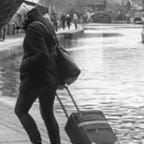School hedges: experiments in improving air quality in Buenos Aires
Caroline Knowles
As city populations and traffic grow, air quality suffers. Globally 4.2 million people died prematurely in 2016 as a result of illnesses related to poor ambient air quality[i]. The World Health Organisation (WHO) reported that over 90% of these deaths were in low-and middle-income countries, in places where some of the worlds’ poorest populations live[ii]. Children are particularly vulnerable to poor air quality, as the effects of nitrous dioxide and particle matter are amplified in small bodies, with potentially disastrous impact on health. Miguel Kanai and Veronica Fabio are leading a multidisciplinary group of Argentine and British researchers, funded by the British Academy’s Global Challenges Research Fund Urban Infrastructures of Well-Being Programme[iii] to experiment with reducing air pollution in three schools in Buenos Aires, where traffic is a major contributor to pollution and there is a diminishing stock of green space.
The project team is planting hedges of ivy, bamboo and native plants around the perimeters of three city-run school playgrounds and then measuring the impact of the hedges on air quality. While a full set of data is still being compiled, there are early indications that ambient air quality is improved inside the hedged playground, compared with outside among busy traffic. Visits to two inner city schools, one with a hedge and the other without, revealed significant sensorial contrasts too in the children’s play space. In one school the ground was bare, tiled, and unshaded; the other was green, shaded and cool.
There are other benefits too. The project team and student helpers have constructed a green classroom inside the hedged school playground. Here, teachers and pupils will learn about the benefits of green infrastructure and the importance of working with nature to find solutions to poor urban air quality. Air pollution is invisible. People need time and the opportunity to learn what it is and how it will affect their health: these are first steps in building popular demand for environmental change, aimed at school children — the citizens of the future.
The day after visiting these two schools, I watched the hedge-building in action in a third school with conditions contrasting its surrounding wealthy area in the suburbs, Bernabé Márquez, in San Isidro[iv]. This has a large playground and great potential for creating green play space. In just one day, as school teachers, university students and academics all pitched in, a piece of scrub-land was transformed into a beautiful garden with an outdoor green classroom. Later, an irrigation system will be added and equipment on both sides of the fence will begin monitoring differences in air quality. Perhaps this data will help to convince the city of Buenos Aires that every school should have a hedge.
The City of Buenos Aires, and its department of Education have their own environmental programme in the ‘Green Schools’ initiative. So far this consists in installing pots of herbs and other plants in school yards, rather than transforming them more extensively into green spaces with hedges and gardens that can provide nature-based solutions. While this is certainly a step in the right direction, and a starting point in developing green education in the city, more extensive transformations that impact air quality are urgently needed. Alongside their experiment with green infrastructure, the project team are discovering the obstacles — bureaucratic and otherwise — to planting hedges around Buenos Aires schools. With this knowledge, they can help to devise policies and strategies to overcome these obstacles and spread green barriers around the city’s schools, one hedge at a time.
[i] WHO Ambient (outdoor) air quality and health Available online: https://www.who.int/en/news-room/fact-sheets/detail/ambient-(outdoor)-air-quality-and-health (accessed on Aug 1, 2019).
[ii] UNEP Air pollution hurts the poorest most Available online: https://www.unenvironment.org/news-and-stories/story/air-pollution-hurts-poorest-most.
[iii] This involves collaboration between Juan Miguel Kanai (PI), Anna Jorgensen and Beverley Inkson at the University of Sheffield, and Veronica Fabio and colleagues at the University of Buenos Aires.
[iv] The school served the poorest members of the neighbourhood, as wealthier families tended to use private education.
